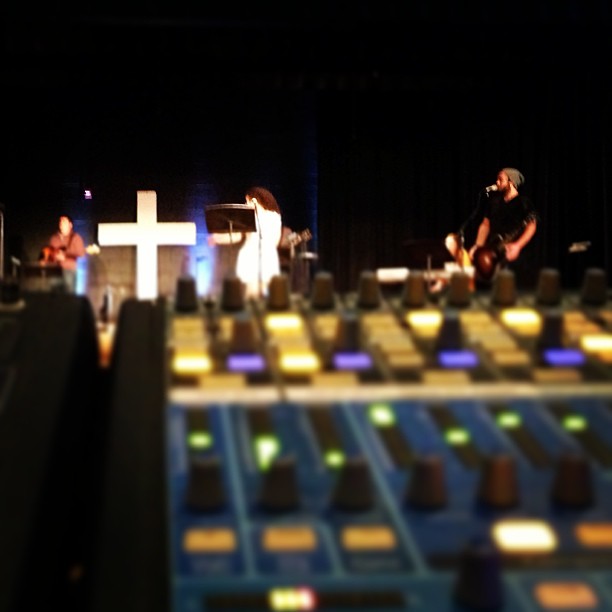Messing with Time and Space- A review of the Radial Phazer Bank
 This blog will deal with time, and phase quite a bit. Unfortunately I don't have the time to go into a lot of the details and physics behind all of it. There is already a lot of information out there. The Yamaha Sound Reinforcement Handbook is a great place to start. You may also want to look at almost anything Dave Rat has written. So with that all in mind...(cue the drum roll)
This blog will deal with time, and phase quite a bit. Unfortunately I don't have the time to go into a lot of the details and physics behind all of it. There is already a lot of information out there. The Yamaha Sound Reinforcement Handbook is a great place to start. You may also want to look at almost anything Dave Rat has written. So with that all in mind...(cue the drum roll)
The Radial Phazer Bank
Let me start by saying the Radial Phazer Bank is an amazing device. Phil at Radial Engineering sent one of these to us at SE Systems a few weeks ago. It's been sitting on my desk for a while because my studio was packed up for a move. The unit has garnered a lot of attention. It's well built, by real Canadians. It's got lots of knobs. It would look great parked in your rig. I have gotten lots of questions about it.
Note that this is not a phaser in the sense of it being a modulation effect, or "rotating speaker" effect, or a funky filter. It's designed to shift audio waveforms so that they sum and work together rather than pulling against each other and canceling stuff out. Radial explains it well here: http://radialeng.com/r2011/phazer.php
The Set Up-
Ideally, I would have loved to test this device in my recording rig at home. I've got a Radial JDX amplifier DI, and some great mics for mic'ing guitar amps. I would have put a Sennheiser e906 on the guitar cab. and plugged the JDX between the amp's speaker output and the speaker cab. Then used the Phazer on the JDX to align the signals. The only problem is, my studio still isn't unpacked.
This past Sunday I used the Phazer Bank in a live situation. The church I volunteer at uses two PreSonus StudioLive 16.4.2 consoles linked together to give us 32 input channels. We utilize the direct outs, and a few auxiliary sends to feed an Aviom personal monitor system. It's a decent console but has a few limitations. We had the following inputs:
- Lead Vocal
- Backing Vocal
- Acoustic Guitar 1
- Acoustic Guitar 2
- Bass
- Keys (Piano Etc)
- Synth
- Electric Guitar 1
- Electric Guitar 2
- Room Mic 1
- Room Mic 2
- Kick Mic 1
- Snare
- Hi-Hat
- Tom 1
- Kick Mic 2 (Normally Tom 2)
- Tom 3
- Ride
- Overhead (Not Used in Main Mix)
- Drum FX
- Vocal FX
- Video Left
- Video Right
- Wireless Hand Held (For announcemnts)
- Wireless Headset (Pastor)
You will probably notice that I have two kick drum mics. I used one dynamic mic inside near the beater to pick up the attack, and a condenser in the bottom of the to pick up the "boom." In a perfect world I would have put a slight delay on the kick drum inputs so that the kit would be "time aligned" with PA system.
Having the kick and PA "aligned" would mean that the speakers are delayed until the sound from the kick travels to the point in space where the speakers are, then the speakers fire. Everything is moving in the same direction at the same time. It can make the difference between hearing the kick and feeling the kick.
Plugging It In
So the PreSonus StudioLive console doesn't have input delays. But I can at least phase align the kick with the PA system. This would mean that the peaks in the drum sounds are lining up with the peaks of the drum sounds coming out of the PA, and the troughs are lined up with the troughs. I inserted one channel of the Phazer Bank each of the two Kick Mics. (Using the inserts on the appropriate channels on the console.)
I left the condenser mic muted while adjusting the Phazer on the dynamic mic. I swept through the shift settings until it sounded full. Then I brought condenser into the mix, swept through the shift setting on it until it sounded super full. The results were amazing. I could feel the kick in my chest and the band wasn't even very loud. In fact before the service, the pastor asked, "why does it seem so loud? You're only hitting 87 dB SPL on your meter." Needless to say I was immediately impressed by the Phazer Bank. I want to buy one. Now. It sounded great!
But Here's the Rub
The Phazer Bank works extremely well. Unfortunately on this particular audio console the channel inserts are pre- direct out. Our direct outs feed the personal monitor system. This means that while I was pulling the kick into alignment with the PA, I was pulling it out of alignment with the drummer's in ear monitor mix. So he was losing the "kick" and "punch" that he usually had. There are ways to fix that, but it's going to take a few more pieces of gear... Or I can just revert to making "good" sound rather than "great" sound. But I still want a Phazer Bank.
~Andy


